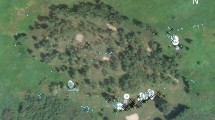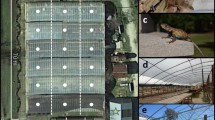Abstract
In Japan, Tatsuno Town has been famous for many Luciola cruciata fireflies emerging every summer at least since the 1920s. However, in the 1960s, L. cruciata fireflies were intentionally introduced from the Lake Biwa area into Matsuo-kyo, the most famous habitat of fireflies in that town. In this study, I examined ambient temperatures and flash rates of L. cruciata at four sites including Matsuo-kyo in the Tatsuno area and two sites in the Lake Biwa area. The linear regression of flash rates on temperatures indicated that the Matsuo-kyo population was distinct from the other three populations native to the Tatsuno area, but similar to the two populations native to the Lake Biwa area in terms of flash rates. These results were also supported by a recent molecular biological study, suggesting that the introduced fireflies had a strong ecological impact on the native ones at Matsuo-kyo. The present study emphasizes that we should not transport and release L. cruciata fireflies without careful consideration.




Similar content being viewed by others
References
Buck J, Buck E (1966) Biology of synchronous flashing of fireflies. Nature 211:562–564. doi:10.1038/211562a0
Carlson AD, Copeland J, Raderman R et al (1976) Role of interflash intervals in a firefly courtship (Photinus macdermotti). Anim Behav 24:786–792. doi:10.1016/S0003-3472(76)80009-7
Hiyori Y, Mizuno T, Kusaoke H (2007) The influence of an intentionally introduced population on the genetic structure of a native population in the Genji-firefly Luciola cruciata. Zenkoku Hotaru Kenkyukai-shi 40:25–27 (an annual journal of the Japan Association for Fireflies Research)
Iguchi Y (2002) The influence of temperature on flash interval in the Genji-firefly Luciola cruciata (Coleoptera: Lampyridae). Ent Rev Jpn 57:119–122
Iguchi Y (2003) History of the introduction of the Genji-firefly at Matsuo-kyo, Tatsuno-machi, Nagano prefecture. Zenkoku Hotaru Kenkyukai-shi 36:13–14 (an annual journal of the Japan Association for Fireflies Research)
Iguchi Y (2006) The interflash interval of the Genji-firefly in Tatsuno town, Nagano prefecture. Zenkoku Hotaru Kenkyukai-shi 39:37–39 (an annual journal of the Japan Association for Fireflies Research)
Katsuno S (1968) The breeding of fireflies in Tatsuno. Konchu to Shizen 3:13–17 (The Nature and Insects)
Kubunden M (1997) Relationship between air temperature and flash interval in the Genji-firefly Luciola cruciata in the Kuroda-gawa district. Kamo to hotaru no machi 7:13–96 (in Japanese)
Lee CE (2002) Evolutionary genetics of invasive species. Trends Ecol Evol 17:386–391. doi:10.1016/S0169-5347(02)02554-5
Lewis SM, Cratsley CK (2008) Flash signal evolution, mate choice, and predation in fireflies. Annu Rev Entomol 53:293–321. doi:10.1146/annurev.ento.53.103106.093346
Lewis SM, Cratsley CK, Demary K (2004) Mate recognition and choice in Photinus fireflies. Ann Zool Fenn 41:809–821
Lloyd JE (1966) Studies on the flash communication system in Photinus fireflies. Univ Mich Misc Publ 130:1–95
Lloyd JE (2000) On research and entomological education IV: quantifying mate search in a perfect insect—seeking true facts and insight (Coleoptera: Lampyridae, Photinus). Fla Entomol 83:211–228. doi:10.2307/3496340
Ludsin SA, Wolfe AD (2001) Biological invasion theory: darwin’s contributions from The Origin of Species. Bioscience 51:780–789. doi:10.1641/0006-3568(2001)051[0780:BITDSC]2.0.CO;2
Mitsuishi T (1990) Genji botaru (The Genji firefly). The Shinano Mainichi Shimbun, Nagano (in Japanese)
Ohba N (1988) Genji Botaru (The Genji firefly). Bun-ichi Sogo Press, Tokyo (in Japanese)
Ohba N (2001) Geographical variation, morphology and flash pattern of the firefly, Luciola cruciata (Coleoptera: Lampyridae). Sci Rept Yokosuka City Mus 48:45–89 (in Japanese with English summary)
Ohba N (2004) Flash communication systems of Japanese fireflies. Integr Comp Biol 44:225–233. doi:10.1093/icb/44.3.225
Sasai S (1999) Relationship between air temperatures and flash intervals in the Genji-firefly Luciola cruciata. Zenkoku Hotaru Kenkyukai-shi 32:22–25 (an annual journal of the Japan Association for Fireflies Research)
Suzuki H (1997) Molecular phylogenetic studies of Japanese fireflies and their mating systems (Coleoptera: Cantharoidea). Tokyo Metro Univ Bull Nat Hist 3:1–53
Suzuki H (2001) Studies on biological diversity of firefly in Japan. Int J Indust Entomol 2:91–105
Takeda M, Amano T, Katoh K et al (2006) The habitat requirement of the Genji-firefly Luciola cruciata (Coleoptera: Lampyridae), a representative endemic species of Japanese rural landscapes. Biodivers Conserv 15:191–203. doi:10.1007/s10531-004-6903-y
Tamura M, Yokoyama J, Ohba N et al (2005) Geographic differences in flash intervals and pre-mating isolation between populations of the Genji firefly, Luciola cruciata. Ecol Entomol 30:241–245. doi:10.1111/j.0307-6946.2005.00683.x
Vencl FV (2004) Allometry and proximate mechanisms of sexual selection in Photirtus fireflies, and some other beetles. Integr Comp Biol 44:242–249. doi:10.1093/icb/44.3.242
Wilcove DS, Rothstein D, Dubow J et al (1998) Quantifying threats to imperiled species in the United States. Bioscience 48:607–615. doi:10.2307/1313420
Zar JH (1996) Biostatistical analysis, 3rd edn. Prentice Hall, New York
Acknowledgments
I am grateful to Professor Hideo Kusaoke for providing published and unpublished data on the mitochondrial DNA of L. cruciata.
Author information
Authors and Affiliations
Corresponding author
Rights and permissions
About this article
Cite this article
Iguchi, Y. The ecological impact of an introduced population on a native population in the firefly Luciola cruciata (Coleoptera: Lampyridae). Biodivers Conserv 18, 2119–2126 (2009). https://doi.org/10.1007/s10531-009-9576-8
Received:
Accepted:
Published:
Issue Date:
DOI: https://doi.org/10.1007/s10531-009-9576-8




